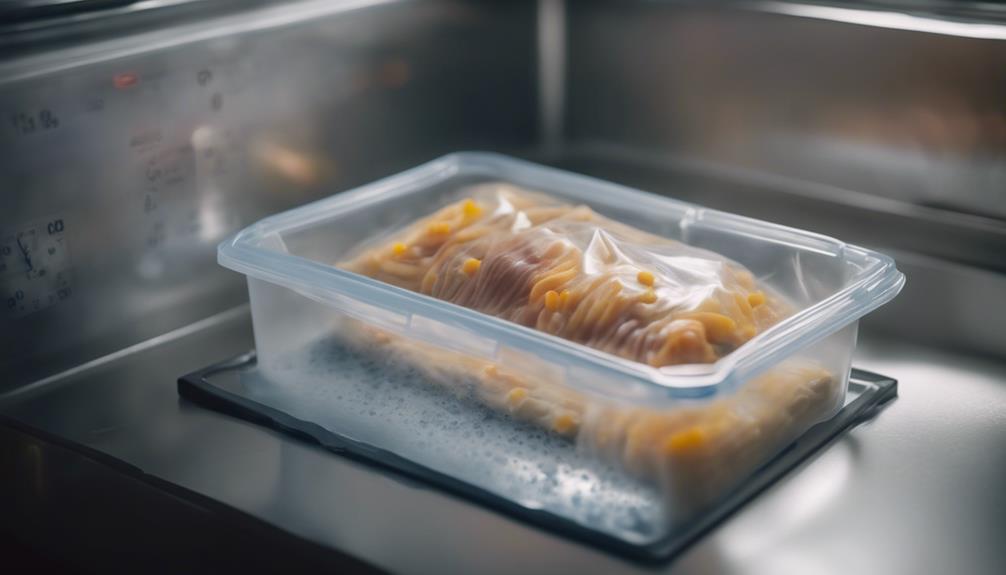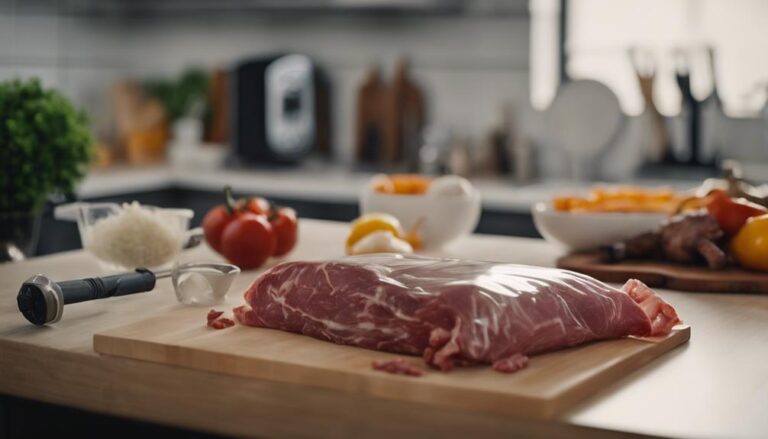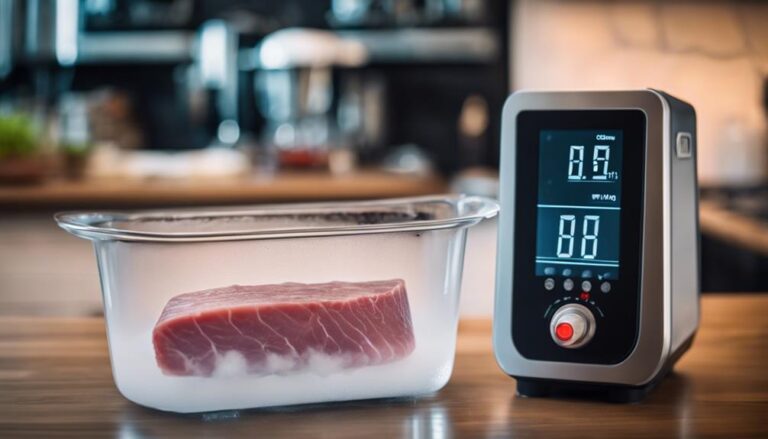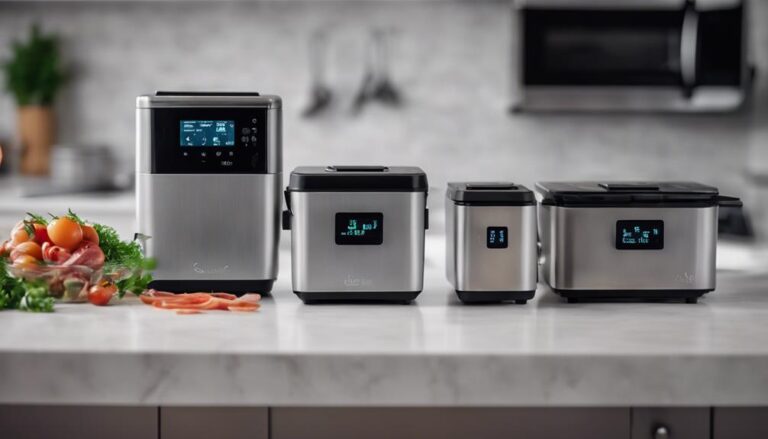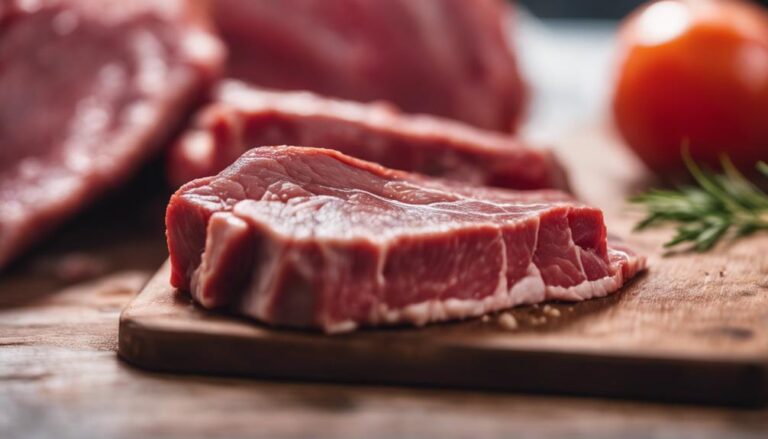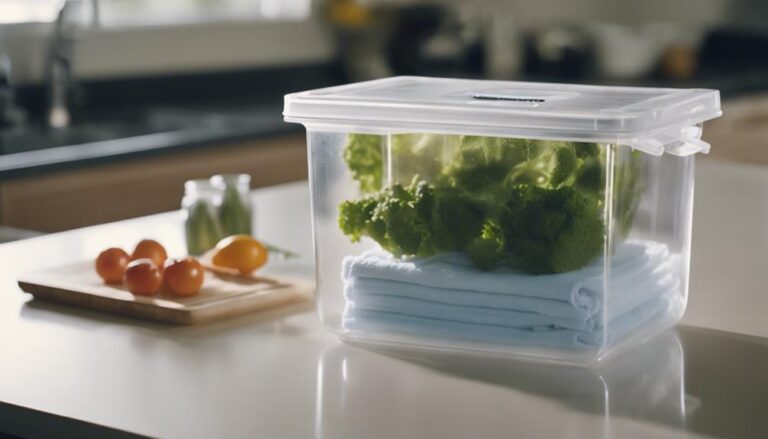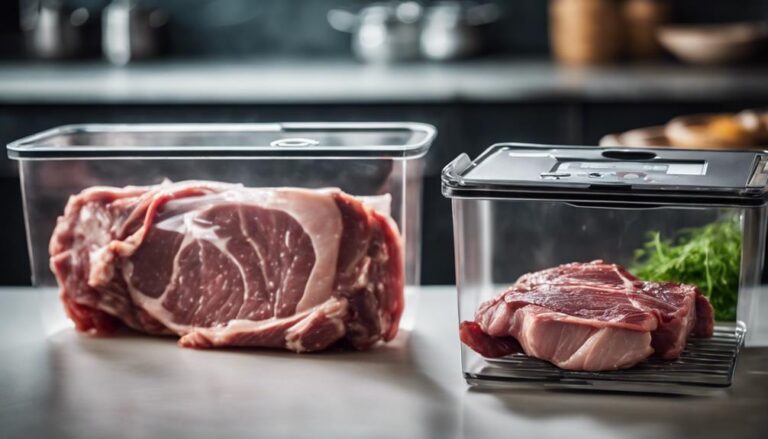How to Store and Reheat Sous Vide Cooked Foods Safely
When storing sous vide cooked foods, seal them tightly in bags to keep them fresh in the fridge for up to 10 days. Use original sous vide bags to maintain flavors and textures. For reheating, make sure to reach or exceed the original cooking temperature, especially for denser foods. A sous vide thermometer can help with precision. If you want to know more about quick cooling techniques, best storage containers, and safe sous vide food handling, there are plenty of tips to guarantee your meals stay delicious and safe to eat. Time to reveal the secrets of sous vide safety!
What You Will Learn Here
- Use sealed bags for extended fridge shelf life.
- Quick cool in ice bath within 2 hours.
- Select appropriate containers for storage.
- Reheat to original temperature for safety.
- Consider sous vide machine for precise reheating.
Importance of Proper Sous Vide Storage
Imagine this: you've just had a delightful sous vide meal, perfectly cooked to juicy perfection. Now, what's next? Well, my food-loving friend, it's all about the storage game.
When it comes to your precious sous vide creations, keeping them in sealed bags can be a game-changer. These bags are like the superhero capes of the food world, extending the shelf life of your goodies for up to 10 days in the fridge. Leftovers stored in their original sous vide bags? They'll thank you by staying fresh and delicious longer than if you transferred them to other containers.
Plus, the flavors and textures you worked so hard to achieve through sous vide cooking? They'll remain intact, safe from any contamination lurking in the shadows.
Quick Cooling Techniques for Sous Vide Foods
After sous vide cooking, ensure efficient and rapid cooling of your foods by promptly transferring them to an ice bath. Imagine this: your beautifully cooked sous vide creation needs to cool down quickly to keep those pesky bacteria at bay. By immersing your pouches into an ice water bath right after cooking, you're basically giving those germs a cold shoulder (literally). This quick cooling technique is like hitting the brakes on bacteria growth, ensuring your food stays safe and delicious.
Why the rush, you ask? Well, fast cooling sous vide foods within 2 hours of cooking is the secret ingredient to minimizing the risk of foodborne illnesses. It's all about upholding those food safety standards like a pro. So, when in doubt, chill it out! Rapidly cooling your sous vide goodies might just be the trendiest move you make in the kitchen. Remember, ice baths aren't just for athletes – they're for your food's safety too!
Best Containers for Sous Vide Food Storage
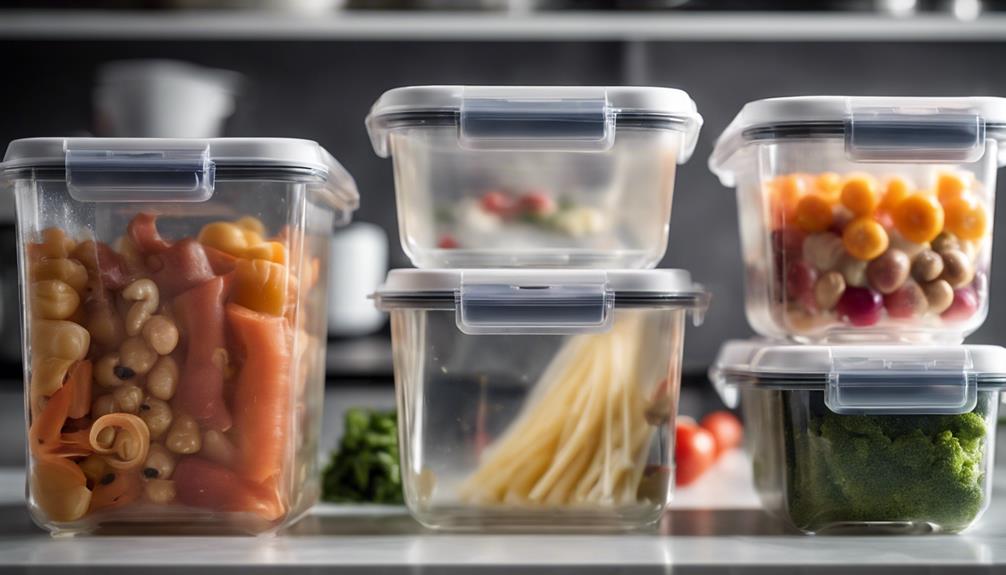
For best storage of sous vide cooked foods, consider using food-grade vacuum seal bags or pouches. These bags are perfect for keeping your delicious meals fresh and flavorful. If you're dealing with liquids or sauces, mason jars with a vacuum sealer attachment can come in handy. They keep everything neatly stored and ready for your next sous vide adventure. For a more eco-friendly option, silicone food storage bags are a great choice. They are reusable and ideal for sous vide food storage. Stasher bags are another fantastic option. These bags provide airtight storage for your sous vide creations and can even be used in a water bath for added convenience. Lastly, vacuum seal containers with airtight lids are a fantastic investment for storing sous vide foods in the fridge or freezer. With these containers, you can rest assured that your meals will stay fresh and delicious until you're ready to enjoy them again.
| Container Type | Best For |
|---|---|
| Vacuum Bags | General Sous Vide Storage |
| Mason Jars | Liquids and Sauces |
| Silicone Bags | Eco-Friendly Choice |
Reheating Sous Vide Foods Safely
To safely reheat sous vide foods, make sure that you reach or exceed the original cooking temperature. It's like giving your food a warm hug to guarantee it's safe to eat. By heating your sous vide goodies to the same temperature or higher, you zap any lurking bacteria back into oblivion.
Remember, denser foods need a bit more time to get that heat all the way through, so don't rush the process. Sous vide reheating isn't just about safety; it's about taste and texture too. Your food will come out feeling like it just had a spa day – refreshed and delightful.
For precise temperature control, consider using a sous vide thermometer. It's like having a food temperature bodyguard, ensuring everything is just right. Just keep in mind to follow those food safety guidelines; we don't want any unexpected guests (bacteria) crashing your delicious meal party.
Using a Sous Vide Machine for Reheating

When reheating cooked foods, utilizing a sous vide machine guarantees precise temperature control for safe and even heating.
This fancy contraption circulates water around your food, treating it like royalty to maintain its original texture and flavor.
Just seal your leftovers in a bag, plop them in the sous vide machine, and let it work its magic. The result? A reheated meal that tastes just as delicious as when it was first cooked.
Plus, using a sous vide machine for reheating is like having your personal chef on standby – convenient and efficient! No more dried-out leftovers or cold spots in your food.
The sous vide method ensures that every bite is heated evenly without the risk of overcooking.
Time and Temperature Guidelines for Reheating
So, you want to make sure your sous vide leftovers are safe and tasty, right? Well, the key is to reheat them at or above the original cooking temperature – safety first!
Remember, consult those handy sous vide cooking times by thickness to nail the perfect reheating time.
Prevent foodborne illness, keep your food excellent, and enjoy those leftovers like a boss!
Reheat Temperatures and Times
For precise temperature control during the reheating process, utilize a sous vide thermometer.
When you're bringing your sous vide cooked foods back to life, remember to heat them at or above the original cooking temperature.
The key here is to follow the recommended guidelines for reheating times, which vary based on the density and thickness of your delicious creations.
Thicker cuts of meat might need a bit more time to reach that perfect, toasty core temperature. So, don't rush it!
By using your sous vide thermometer diligently, you can avoid the dreaded overcooking scenario while maintaining that mouthwatering taste and texture.
It's all about finding that sweet spot between reheating efficiently and preserving the quality of your food.
Safe Reheating Practices
To guarantee the safe reheating of sous vide cooked foods, adhere to specific time and temperature guidelines. When it's time to reheat your delicious sous vide creations, remember the golden rule: heat them up at or above the temperature they were originally cooked at.
A sous vide machine is your trusty sidekick for this task, ensuring even heating without the risk of overcooking. Take into account the density of your food when calculating reheating time – denser goodies need a bit more love.
Tender cuts of meat usually need 2-3 hours to reach that perfect temp. For dishes like curries, consider reheating in the sauce to avoid overcooking and amp up those flavors. Your taste buds will thank you!
Preventing Foodborne Illness
Properly reheating sous vide cooked foods to an internal temperature of at least 165°F for 15 seconds is essential in preventing foodborne illness. Remember, it's all about zapping those pesky bacteria that might be lingering around. By hitting that magic number, you're ensuring your food is safe to devour without any unwanted hitchhikers.
So, grab your trusty food thermometer – it's your kitchen sidekick in this quest for safety. Don't give those germs a chance to crash your delicious meal party! Following the time and temperature guidelines is like giving those bacteria a one-way ticket out of your food.
Stay cool, store your cooked goodies properly, and reheat like a pro. Your stomach will thank you!
Avoiding Overcooking When Reheating
When reheating sous vide cooked foods, ensuring that you don't overcook them is essential to preserving their quality and flavor. To avoid turning your perfectly cooked meal into a rubbery disaster, opt for a lower temperature when reheating.
Stick to around the temperature you originally cooked your food at, and you'll keep it from going from gourmet to 'oops, I did it again.' Remember, denser foods like that juicy steak might need a few extra minutes per inch to make sure they're heated through without resembling your old chewing gum collection.
If you're unsure about the internal temperature, using a sous vide thermometer can be your kitchen sidekick, helping you monitor the heat precisely. This method not only prevents overcooking but also maintains that ideal texture and taste you worked so hard to achieve.
Benefits of Using a Sous Vide Thermometer
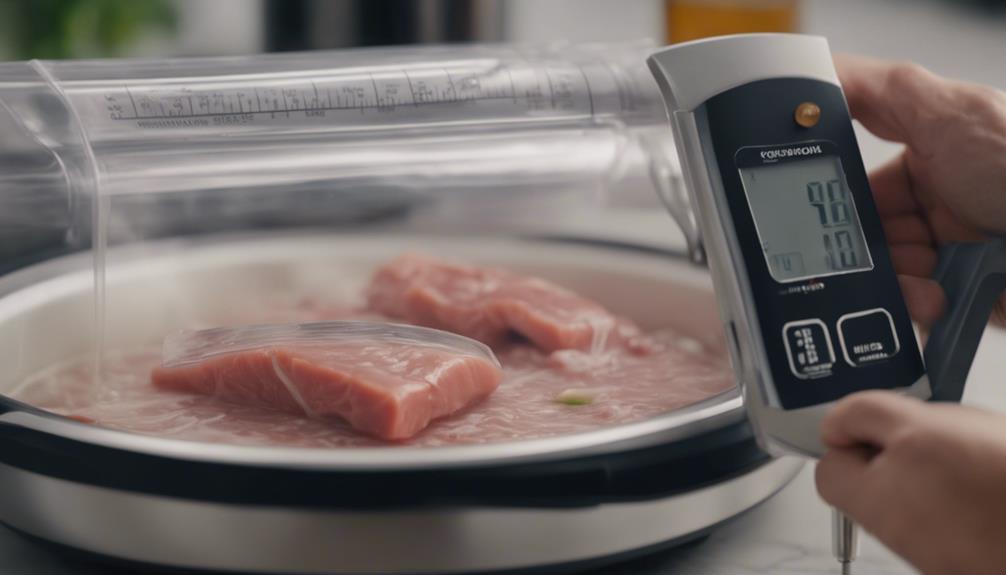
If you want to enhance your sous vide cooking game, consider the advantages of incorporating a sous vide thermometer into your culinary toolkit. Here are some benefits of using a sous vide thermometer:
- Precise Temperature Control: A sous vide thermometer guarantees that your cooking temperature remains precise, helping you achieve the perfect degree of doneness every time.
- Prevents Overcooking or Undercooking: Say goodbye to dry, overcooked steaks or underdone chicken breasts. The thermometer lets you cook your food to perfection.
- Consistent Monitoring: With a sous vide thermometer, you can monitor the water bath temperature consistently, leading to ideal results without the guesswork.
Using a sous vide thermometer not only helps you cook like a pro but also assures that your food is safe to eat. So, why not add this handy tool to your kitchen arsenal and take your sous vide cooking to the next level?
Ensuring Precise Heating for Different Foods
To guarantee peak results when cooking a variety of foods sous vide, exact heating based on each item's unique characteristics, such as density, thickness, and composition, is essential. Think of it like giving each food item its personalized spa treatment; after all, your steak and your veggies have different relaxation needs.
Adjust the heating times like a pro for your flat steak, cylindrical roulade, or those fancy spherical shapes. Don't leave them hanging in the sous vide bath too long; they've places to be and flavors to develop! Use that handy sous vide thermometer to make sure your meat is getting the VIP treatment it deserves.
When regenerating meat, go easy on the heat to keep that quality first-rate and extend its shelf life. Remember, following the recommended heating times isn't just a suggestion; it's the secret recipe to prevent overcooking disasters and maintain that perfect texture you've been dreaming of.
Time to get cooking, sous vide style!
Tips for Safe Sous Vide Food Handling
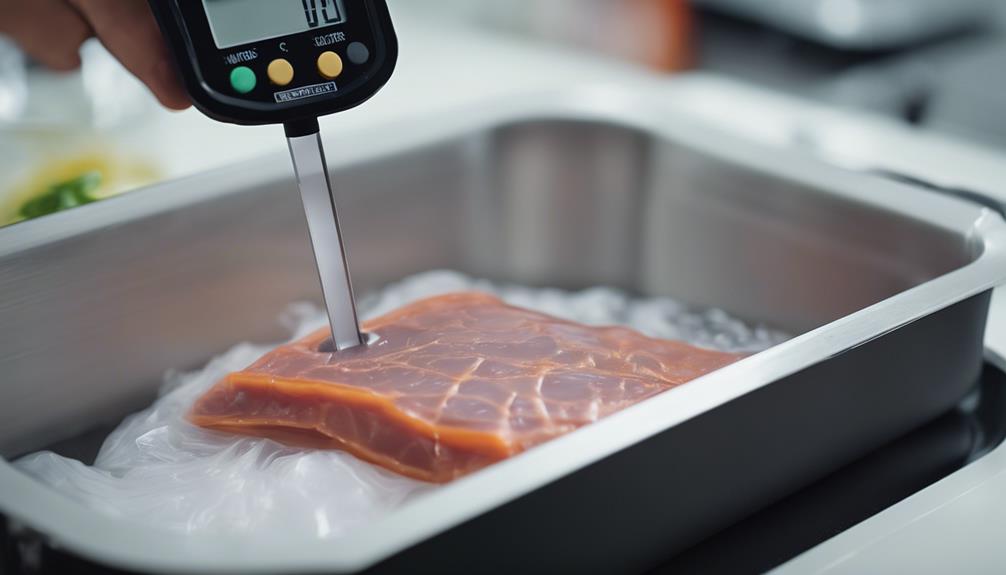
Hey there, so you're diving into the world of sous vide cooking, but have you considered the importance of safe food handling practices?
Let's chat about food temperature control and the proper storage techniques to keep your sous vide creations fresh and safe to eat.
It's all about making sure your delicious meals stay tasty and bacteria-free!
Food Temperature Control
For safe handling of sous vide cooked foods, maintain temperatures above 130°F to prevent bacterial growth and guarantee food safety. When dealing with sous vide delicacies, remember these key temperature tips:
- Keep It Hot: Maintain your cooked foods above 130°F to keep those pesky bacteria at bay.
- Cool It Down: Once you're done feasting, make sure to chill and store your sous vide creations below 40°F to keep them fresh and safe.
- Heat Things Up: When it's time to reheat, aim for 130°F or higher to zap any lingering bacteria and enjoy your meal worry-free. Remember, precision and care in temperature control are the secret ingredients to sous vide success!
Proper Storage Techniques
When storing sous vide cooked foods, make sure you use vacuum-sealed bags to maintain freshness and extend shelf life. It's like giving your food a cozy little hug to keep it happy for longer.
Remember to refrigerate your cooked sous vide goodies in their original sealed bags for up to 10 days – that's almost two weeks of deliciousness waiting for you. Leftovers stored in opened bags won't last as long, so keep them sealed up tight.
Foods stored in their original sous vide bags are the real MVPs when it comes to shelf life. Properly cooled and sealed sous vide foods can hold onto their freshness like a champ, so don't let those tasty treats go to waste!
Frequently Asked Questions
How Do You Store Food After Sous Vide?
When you store food after sous vide, remember proper storage techniques are crucial. Guarantee freshness and food safety by transferring leftovers to new sealed bags before reheating. Follow these tips to maintain taste and quality.
Can You Leave Food in the Bag After Cooking Sous Vide?
You can safely leave food in the sous vide bag after cooking, ensuring freshness and flavor. Properly seal and refrigerate the bag to prevent contamination and bacterial growth. Follow food safety guidelines for storage to maintain quality.
What to Do With Sous Vide After Cooking?
After cooking sous vide, you can store your leftovers in the fridge or freezer in sealed pouches for later. Reheat them easily by placing the pouch back in the sous vide machine. This method preserves the food's flavor and texture.
Can You Cook Sous Vide in Advance?
You can absolutely prepare sous vide meals in advance for convenient meal prep. Season and seal uncooked food, then refrigerate or freeze for later cooking. This method not only saves time but also helps maintain flavorful profiles.
Conclusion
So there you have it, folks! Properly storing and reheating sous vide cooked foods is key to maintaining their deliciousness and safety.
Remember to cool them quickly, use the right containers, and reheat them with precision using a sous vide machine and thermometer.
With these tips, you'll be a sous vide pro in no time, impressing your friends and family with perfectly cooked meals every time.
Happy cooking!
